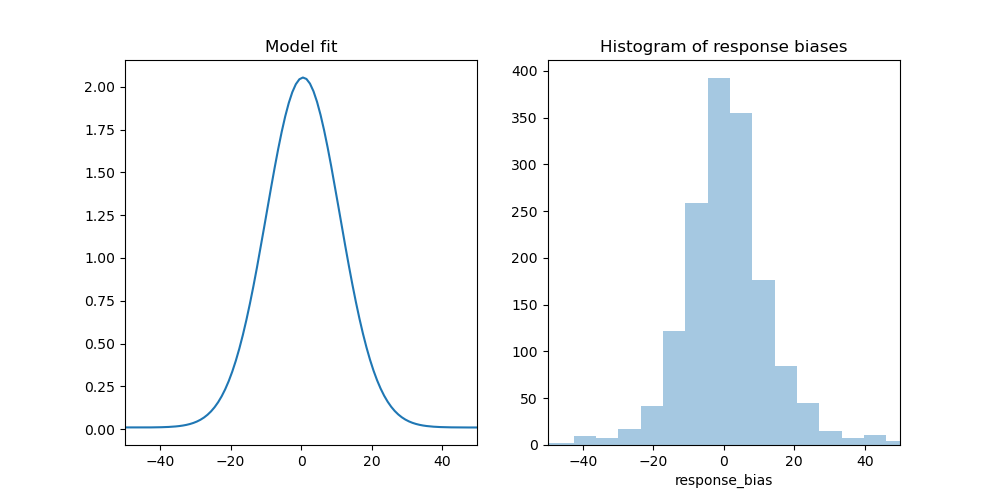Mixture modeling for working-memory experiments
Project description
Biased Memory Toolbox
A Python toolbox for mixture modeling of data from visual-working-memory experiments
Cherie Zhou (@cherieai) and Sebastiaan Mathôt (@smathot)
Copyright 2020 - 2021
Citation
Zhou, C., Lorist, M., Mathôt, S., (2021). Categorical bias in visual working memory: The effect of memory load and retention interval. Cortex. https://osf.io/puq4v/
This manuscript is a Stage 1 in-principle acceptance of a registered report
Installation
pip install biased_memory_toolbox
Usage
This section focuses on using the module, assuming that you have a basic understanding of mixture modeling of working memory data. If you want to know more about the theory behind mixture modeling, please read (for example) the manuscript cited above.
We start by reading in a data file using DataMatrix. The data should contain a column that contains the memoranda (here: memory_hue) and a column that contains the responses (here: response_hue), both in degrees with values between 0 and 360.
from datamatrix import io
dm = io.readtxt('example-data/example-participant.csv')
As a first step, which is not related to mixture modeling per se, we check whether the participant performed significantly (p < .05) above chance. This is done with a permutation test that is implemented as test_chance_performance(). Here, low p-values indicate that performance deviates from chance.
import biased_memory_toolbox as bmt
t, p = bmt.test_chance_performance(dm.memory_hue, dm.response_hue)
print('testing performance: t = {:.4f}, p = {:.4f}'.format(t, p))
Output:
testing performance: t = -54.4475, p = 0.0000
Now let's fit the mixture model. We start with a basic model in which only the precision and the guess rate is estimated, as in the original Zhang and Luck (2008) paper.
To do so, we first calculate the response error, which is simply the circular distance between the memory hue (the color that the participant needed to remember) and the response hue (the color that the participant reproduced). This is done with response_bias(), which, when no categories are provided, simply calculates the response error.
dm.response_error = bmt.response_bias(dm.memory_hue, dm.response_hue)
We can fit the model with a simple call to fix_mixture_model(). By specifying include_bias=False, we fix the bias parameter (the mean of the distribution) at 0, and thus
only get two parameters: the precision and the guess rate.
precision, guess_rate = bmt.fit_mixture_model(
dm.response_error,
include_bias=False
)
print('precision: {:.4f}, guess rate: {:.4f}'.format(precision, guess_rate))
Output:
precision: 1721.6386, guess rate: 0.0627
Now let's fit a slightly more complex model that also includes a bias parameter. To do so, we first calculate the response 'bias', which is similar to the response error except that it is recoded such that positive values reflect a response error towards the prototype of the category that the memorandum belongs to. For example, if the participant saw a slightly aqua-ish shade of green but reproduced a pure green, then this would correspond to a positive response bias for that response.
To calculate the response bias we need to specify a dict with category boundaries and prototypes when calling response_bias(). A sensible default (DEFAULT_CATEGORIES), based on ratings of human participants, is provided with the toolbox.
dm.response_bias = bmt.response_bias(
dm.memory_hue,
dm.response_hue,
categories=bmt.DEFAULT_CATEGORIES
)
Next we fit the model again by calling fit_mixture_model(). We now also get a bias parameter (because we did not specify include_bias=False) as described in Zhou, Lorist, and Mathôt (2021).
precision, guess_rate, bias = bmt.fit_mixture_model(dm.response_bias)
print(
'precision: {:.4f}, guess rate: {:.4f}, bias: {:.4f}'.format(
precision,
guess_rate,
bias
)
)
Output:
precision: 1725.9568, guess rate: 0.0626, bias: 0.5481
It also makes sense to visualize the model fit, to see if the model accurately captures the pattern of responses. We can do this by plotting a probability density function, which can be generated by mixture_model_pdf().
import numpy as np
import seaborn as sns
from matplotlib import pyplot as plt
x = np.linspace(-180, 180, 360)
y = bmt.mixture_model_pdf(x, precision, guess_rate, bias)
plt.figure(figsize=(10, 5))
plt.subplot(121)
plt.title('Model fit')
plt.xlim(-50, 50)
plt.plot(x, y)
plt.subplot(122)
plt.title('Histogram of response biases')
plt.xlim(-50, 50)
sns.distplot(dm.response_bias, kde=False)
plt.savefig('example.png')
We can also fit a model that takes into account swap errors, as described by Bays, Catalao, and Husain (2009). To do so, we need to also specify the response bias (or plain error) with respect to the non-target items.
Here, we select only those trials in which the set size was 3, and then create two new columns for the response bias with respect to the second and third memory colors, which were non-targets in this experiment. (The first color was the target color.)
dm3 = dm.set_size == 3
dm3.response_bias_nontarget2 = bmt.response_bias(
dm3.hue2,
dm3.response_hue,
categories=bmt.DEFAULT_CATEGORIES
)
dm3.response_bias_nontarget3 = bmt.response_bias(
dm3.hue3,
dm3.response_hue,
categories=bmt.DEFAULT_CATEGORIES
)
By passing a list of non-target response biases, we get a fourth parameter: swap rate.
precision, guess_rate, bias, swap_rate = bmt.fit_mixture_model(
x=dm3.response_bias,
x_nontargets=[
dm3.response_bias_nontarget2,
dm3.response_bias_nontarget3
],
)
print(
'precision: {:.4f}, guess rate: {:.4f}, bias: {:.4f}, swap_rate: {:.4f}'.format(
precision,
guess_rate,
bias,
swap_rate
)
)
Output:
precision: 1458.9628, guess rate: 0.0502, bias: 1.2271, swap_rate: 0.0191
License
biased_memory_toolbox is licensed under the GNU General Public License
v3.
Project details
Download files
Download the file for your platform. If you're not sure which to choose, learn more about installing packages.
Source Distribution
Built Distribution
File details
Details for the file biased_memory_toolbox-1.2.0.tar.gz.
File metadata
- Download URL: biased_memory_toolbox-1.2.0.tar.gz
- Upload date:
- Size: 7.1 kB
- Tags: Source
- Uploaded using Trusted Publishing? No
- Uploaded via: twine/3.4.1 importlib_metadata/4.5.0 pkginfo/1.7.0 requests/2.25.1 requests-toolbelt/0.9.1 tqdm/4.60.0 CPython/3.9.4
File hashes
| Algorithm | Hash digest | |
|---|---|---|
| SHA256 | a94c22355eb14cb62bcccc4a5adf92366e3e937fba45a161117be3076e1bff32 |
|
| MD5 | 0bb24b10bd0f932349953c81000ccfb2 |
|
| BLAKE2b-256 | a2ac089cbeb47c59c6b9b929ac552fcaf4e68c7487e7af53aec2ac4dee9a6b1e |
File details
Details for the file biased_memory_toolbox-1.2.0-py3-none-any.whl.
File metadata
- Download URL: biased_memory_toolbox-1.2.0-py3-none-any.whl
- Upload date:
- Size: 19.7 kB
- Tags: Python 3
- Uploaded using Trusted Publishing? No
- Uploaded via: twine/3.4.1 importlib_metadata/4.5.0 pkginfo/1.7.0 requests/2.25.1 requests-toolbelt/0.9.1 tqdm/4.60.0 CPython/3.9.4
File hashes
| Algorithm | Hash digest | |
|---|---|---|
| SHA256 | f1ef1e6abc834a09f34ee781cbcafb641d4c0bd67631fde9098ae673602b633b |
|
| MD5 | 4987f78979224476070b56f9f8b0cbc3 |
|
| BLAKE2b-256 | 23c4b94bafcc0c440fe538509ab6c5e70fe4faf070811457b7f1f26a2f7bffee |













